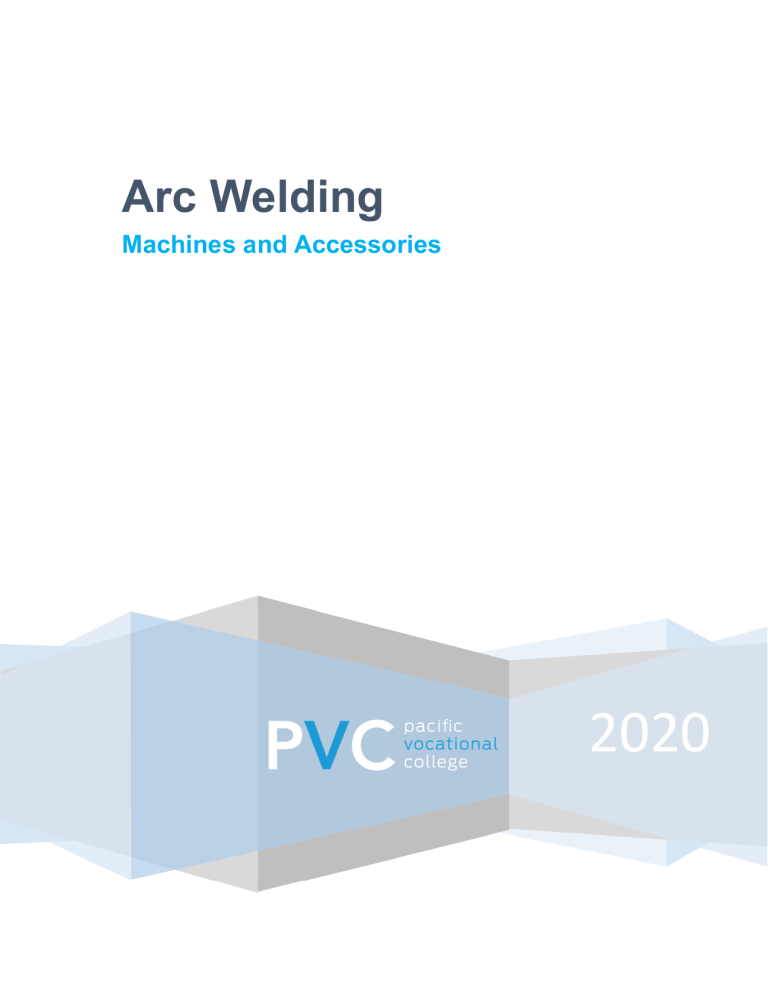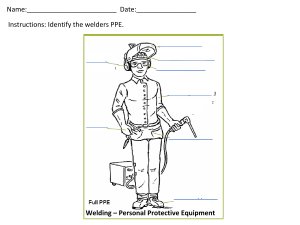
Arc Welding Machines and Accessories 2020 © 2020 by Pacific Vocational College Ltd. Burnaby, British Columbia All rights reserved. No part of this manual may be reproduced in any form, without permission in writing from Pacific Vocational College Ltd. Table of Figures Figure 1 - AC Transformer Welder and DC Motor Generator Welder .......................................................... 1 Figure 2 - AC and DC Welders ....................................................................................................................... 3 Figure 3 - Welding Accessories ..................................................................................................................... 4 Machines and Accessories, Arc Welding © Pacific Vocational College, 2020 i Arc Welding Machines and Accessories The success of welding as a metal-joining process rests on the fact that a good weld with common steels is as strong as or stronger than the plate in which it is made. This success has been established through the years by the gradual development of welding machines, accessories and electrodes that satisfy the complex requirements of the arc process. Arc welding requires a continuous supply of electric current, sufficient in amount (amperes) and of proper voltage to maintain an arc. This current may be either alternating (AC) or direct (DC), but it must be provided through a source that can be adjusted. Several different types of welding machines are available for producing satisfactory welding current. Alternating current is produced in special welding transformers. Direct current is produced in either electric motor-generator sets, rectifier sets, or enginedriven generator sets. Combination welders, producing both AC and DC are basically transformer-rectifier sets. Figure 1 - AC Transformer Welder and DC Motor Generator Welder Welding machines are rated according to their current output, voltage and duty cycle and are available in a wide range of sizes. The National Electrical Manufacturers Association establishes minimum standards for rating welding machines and most manufacturers follow these standards. The standards are established on a conservative basis, requiring a rating well below the maximum overload capacity of the machine so that it will provide safe operation efficiently over a long period of time. Ratings are given with a percentage duty cycle. The duty cycle of a welder is the percentage of a ten-minute period that a welder can operate at a given output current setting. If a welder is rated 300 amperes at a 60% duty cycle, it means that the machine can be operated safely at 300 amperes welding current for 6 out of every 10 minutes. If this duty cycle is reduced in actual operation, the Machines and Accessories, Arc Welding © Pacific Vocational College, 2020 1 maximum permissible current is increased. At 35% duty cycle, a 300-ampere machine could be operated at 375 amperes. Transformer welders are available for operation on single-phase power lines. They transform high-voltage-low-amperage input current to a low-voltage-high-amperage welding current. Current controls must be provided on the transformer to permit its use for welding. There are three basically different types of current-control systems. One type of current control is the movable iron core operated by a crank. This is a continuous current control. A second type is the solid-state electrical circuitry, which is also continuous control. The other is a tap-type control, in which the electrode leads are plugged into different jacks, or taps, to obtain different settings. All accurately regulate the welding current, with either, the operator can select just the welding heat he/she wants. Rectifier sets are basically three-phase or single-phase transformers to which have been added silicon or other rectifiers to change the output current from alternating to direct current. These machines have the basic control and output characteristics that are inherent in transformers. Direct-current generators use an armature rotating in an electrical field. Current is generated in the armature and is taken off for the use through a commutator. The armature is rotated either by an electric motor or an internal combustion engine. When generators are engine-operated, they are independent of electric power and may be operated in the field where power is not available. Combination welders, producing both AC and DC current, are the most versatile of all types of welders. They are basically a single-phase transformer and a rectifier from which, by turning a switch, either alternating or direct welding current is available. With DC, polarity can be switched to either electrode positive or electrode negative. Several factors must be evaluated when selecting a welding power source. The size or rated output of a machine required for a given job depends on the thickness of the metal to be welded and the amount of welding to be done. There is no need to buy more capacity than will be required by the job. Be sure, however, to check the duty cycle. Machines with a low duty cycle should be used only for maintenance or intermittent welding. 60% duty cycle is normal for industrial welders. Continued operation of a machine beyond its rated capacity will shorten its service life. Machines and Accessories, Arc Welding © Pacific Vocational College, 2020 2 Figure 2 – AC and DC Welders In selecting the welder, another consideration is the utility power available. Fortunately, welders are made to be used with all types of power, but certain types are available for only given conditions. Motor-generator sets are generally available for only three-phase AC power, but can be ordered to different cycles and voltages. They are also available for DC power. AC machines are generally available for only single-phase AC power in various cycles, with or without power-factor correction in the machine. Fortunately, in most manufacturing situations, the source of power does not present a limiting factor on the selection of the welder. The decision can be made on the basis of what is the most efficient and economical machine for a given job. Also, consider what type machine will make the job easiest to do and enable better welding to be done at lower costs. There is one best way to do every welding job. Input power to the welder should be planned and installed only by qualified electricians. Lines should be of the proper size and properly fused, according to local requirements and current standards. Current-carrying cables, cable lugs, electrode holder, work clamp, weld-cleaning devices and protective equipment are essential for each welding machine and operator. These are called accessories. For maximum safety and efficiency, good quality accessories must be used. Machines and Accessories, Arc Welding © Pacific Vocational College, 2020 3 The welding current is conducted from the source of power to the electrode holder by an insulated copper, extra-flexible cable. This cable is designed expressly for welding and derives its flexibility from the thousands of very fine, almost hair-like wires enclosed in a durable paper wrapping that allows the conductor to slip readily within its insulation when the cable is bent. The high-grade insulation also contributes to flexibility. Wear resistance is provided in this cable by an extra tough, braided cotton reinforcing and by the special composition of the covering, which provides a smooth finish, highly resistant to abrasion. For completing the welding circuit, a somewhat less flexible, but equally wear-resistant cable is used. Hand Shield Figure 3 – Welding Accessories The size (diameter) of the cables used in welding varies, depending upon the capacity of the machine and the length of cable required. Cable size is selected carefully because of its current carrying capacity. The cable is generally connected to the welder by means of a copper terminal lug. This lug is soldered or clamped to the end of the cable and fits on the welder terminal post. The electrode holder grips the electrode during the welding process. This holder should be reasonably light, well-insulated and sturdy enough to withstand the wear of continual handling. The holder should be the correct size for maximum machine output. A springgrip holder for quick insertion or release of the electrode is best. A work clamp fastened to the work or the table on which the work is mounted completes the welding circuit. A spring-pressure work clamp is the quickest and easiest to use. Magnetic clamps are available and may be necessary for a secure connection on broad surfaces where it is difficult to use spring-pressure work clamps. A shield for the face and eyes is necessary for protection from arc rays and heat and the spatter of molten metal. This shield may have a head band for wearing on the head or a handle attached for holding in the hand. The head shield is most commonly used Machines and Accessories, Arc Welding © Pacific Vocational College, 2020 4 for welding, as both hands are usually needed for the welding process. The shield should have a number 10 or 12 filter glass for general purpose welding. The more expensive filter glass should be protected by a clear cover-glass, which may be replaced when covered with arc spatter. Gloves and apron should be of chrome-tanned leather to protect the hands, body and clothes from heat and spatter. If welding is done in positions other than flat, leather shoulders and sleeves must be worn. Safety glasses should be worn under the shield to protect the welder’s eyes when chipping hot slag, grinding metal for joint preparation and cleaning metal with the wire brush. A chipping hammer and wire scratch brush should be used to thoroughly clean the beads. A workbench soon becomes spattered and burned. This table should be steel for fire-proofness and ease of grounding work. It may be easily made in the shop. Protection for other persons working in the shop may be provided around the welding area by a booth or shield of fireproof canvas, sheet metal, or transit. This might be a permanent or portable unit, depending upon the work being done. Machines and Accessories, Arc Welding © Pacific Vocational College, 2020 5 Edits: Last revision – March 4, 2021 by Alexandra Permiakova March 10, 2020 by Richa Devgun September 12, 2019 by Jennifer Bradbury April 30th, 2019 by Sandor Rethy Machines and Accessories, Arc Welding © Pacific Vocational College, 2020 6


